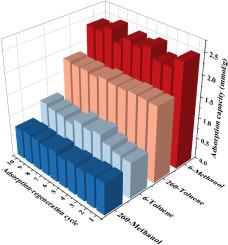Adsorption performance and mechanism of single-component and multi-component VOCs by Beta zeolites with different Si/Al ratios
IF 4.8
3区 材料科学
Q1 CHEMISTRY, APPLIED
引用次数: 0
Abstract
The physical and chemical properties of VOCs and zeolite materials generally affect adsorption efficacy for VOCs removal. Here, toluene and methanol were chosen as typical VOCs with different polarities and molecular diameters to investigate the performance and mechanism of their adsorption on Beta zeolites with various Si/Al ratios. It was found that high-silica Beta exhibited superior toluene adsorption capacity, while low-silica Beta showed higher methanol adsorption capacity. Compared with single-component adsorption, in the case of co-adsorption of toluene and methanol, the saturation adsorption capacities for toluene and methanol only changed slightly even with the existence of competitive adsorption and weakened adsorption strength. Importantly, there was almost no decrease in absorption capacity after 10 repeated adsorption-regeneration cycles, showing the excellent reusability of Beta zeolites for toluene and methanol removal. Whether on low-silica or high-silica Beta, physical adsorption of toluene and methanol was dominant, along with a small proportion of chemical adsorption on low-silica Beta based on acid sites. Similar size between the diameters of toluene and the pore channels of Beta zeolites was responsible for strong adsorption force, increase of adsorption capacity, and minor effect on absorption performance in the process of competitive adsorption. Strong interaction between acid sites and polar methanol through H-bond or non-polar toluene by electrostatic attraction promoted chemical adsorption. Furthermore, toluene and methanol both tended to absorb in the twelve-membered-ring of Beta zeolites on Si-OH-Al, Al-OH, and Si-OH sites. This study provides insight into the factors influencing the adsorption performance and mechanism of toluene and methanol on zeolites, which gives potential guidance for the selection of adsorbents for high-efficiency VOCs removal.

不同硅/铝比 Beta 沸石对单组分和多组分挥发性有机化合物的吸附性能和机理
挥发性有机化合物和沸石材料的物理和化学特性通常会影响对挥发性有机化合物的吸附去除效果。本文选择甲苯和甲醇作为具有不同极性和分子直径的典型挥发性有机化合物,研究它们在不同硅/铝比例的 Beta 沸石上的吸附性能和机理。研究发现,高硅 Beta 具有更强的甲苯吸附能力,而低硅 Beta 则具有更强的甲醇吸附能力。与单组分吸附相比,在甲苯和甲醇共吸附的情况下,即使存在竞争吸附和吸附强度减弱的情况,甲苯和甲醇的饱和吸附容量也只是略有变化。重要的是,经过 10 次重复吸附-再生循环后,吸附容量几乎没有下降,这表明 Beta 沸石在去除甲苯和甲醇方面具有极佳的重复使用性。无论是在低硅还是高硅 Beta 上,甲苯和甲醇的物理吸附都占主导地位,而在低硅 Beta 上,基于酸性位点的化学吸附只占一小部分。在竞争吸附过程中,甲苯直径与 Beta 沸石孔道直径相近,因此吸附力强,吸附容量增大,而对吸附性能的影响较小。酸性位点通过 H 键与极性甲醇或通过静电吸引与非极性甲苯之间的强相互作用促进了化学吸附。此外,甲苯和甲醇都倾向于在 Beta 沸石的 Si-OH-Al、Al-OH 和 Si-OH 位点上的十二元环中吸附。这项研究深入探讨了沸石对甲苯和甲醇的吸附性能和机理的影响因素,为高效去除挥发性有机化合物的吸附剂选择提供了潜在的指导。
本文章由计算机程序翻译,如有差异,请以英文原文为准。
求助全文
约1分钟内获得全文
求助全文
来源期刊

Microporous and Mesoporous Materials
化学-材料科学:综合
CiteScore
10.70
自引率
5.80%
发文量
649
审稿时长
26 days
期刊介绍:
Microporous and Mesoporous Materials covers novel and significant aspects of porous solids classified as either microporous (pore size up to 2 nm) or mesoporous (pore size 2 to 50 nm). The porosity should have a specific impact on the material properties or application. Typical examples are zeolites and zeolite-like materials, pillared materials, clathrasils and clathrates, carbon molecular sieves, ordered mesoporous materials, organic/inorganic porous hybrid materials, or porous metal oxides. Both natural and synthetic porous materials are within the scope of the journal.
Topics which are particularly of interest include:
All aspects of natural microporous and mesoporous solids
The synthesis of crystalline or amorphous porous materials
The physico-chemical characterization of microporous and mesoporous solids, especially spectroscopic and microscopic
The modification of microporous and mesoporous solids, for example by ion exchange or solid-state reactions
All topics related to diffusion of mobile species in the pores of microporous and mesoporous materials
Adsorption (and other separation techniques) using microporous or mesoporous adsorbents
Catalysis by microporous and mesoporous materials
Host/guest interactions
Theoretical chemistry and modelling of host/guest interactions
All topics related to the application of microporous and mesoporous materials in industrial catalysis, separation technology, environmental protection, electrochemistry, membranes, sensors, optical devices, etc.
 求助内容:
求助内容: 应助结果提醒方式:
应助结果提醒方式:


